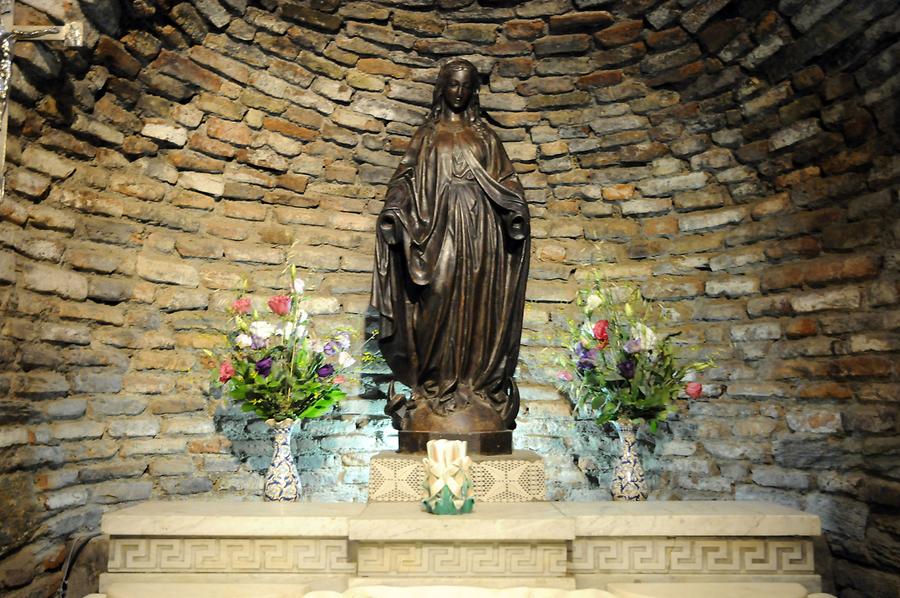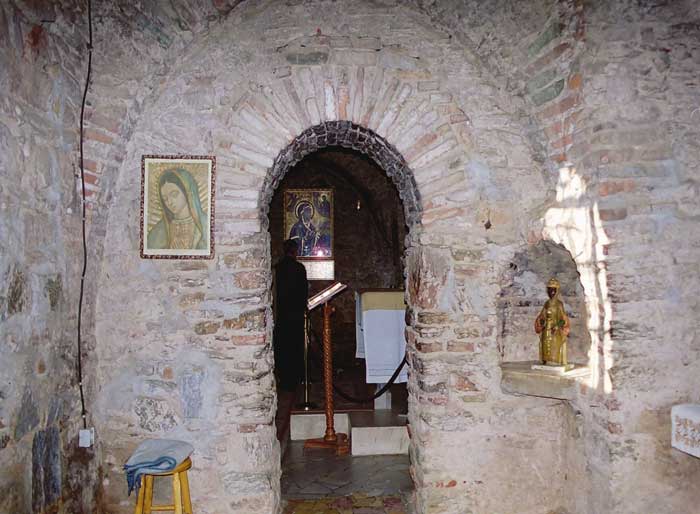Table Of Content
The House of the Virgin Mary bridges the past and present, connecting people of diverse backgrounds through faith, history, and spirituality. As pilgrims and tourists continue to flock to this sacred sanctuary, its legacy as a place of profound significance remains eternal. At the end of the visit to the Virgin Mary’s House, you will find three fountains on the right side, a few steps down. There is a small gift shop near the stairs, run by the Virgin Mary Association, which was founded by both Muslims and Christians in the area. The association relies solely on donations and the turnover of this little gift shop for revenue.
Terrace Houses in Ephesus: Uncovering the Lives of the Wealthy in Ancient Times
He became one of Emmerich's supporters at the time and wrote down the revelations she experienced. From 1819 until Emmerich's death in 1824, Brentano filled many notebooks with accounts of her visions, including the scenes from the New Testament and the life of the Virgin Mary. Only nine years after Emmerich's death, Brentano completed editing his records for publication.
Position of the Roman Catholic Church
Anne, the nun, and the priest, never went to Ephesus and, excavation work had not started. The priest believed he had found the Virgin Mary’s house, yet it took many years to convince others worldwide. These days as well as being a shrine, the house functions as a chapel and place of worship.
The Basilica of St John
This hill overlooked the Aegean Sea to the west and the ruins of ancient Ephesus to the north. Gouyet believed that the ruined building was the one described by Emmerich and that it really was the House of St. Mary, where she had spent the final years of her life. Christian historians contend that in his dying moments, Jesus entrusted his mother to the care of his friend and apostle, John. Following the crucifixion, St John duly rescued Mary from the perilous crimes of Jerusalem and brought her to Ephesus.
Over the years, numerous pilgrims have reported experiencing miracles, healing, and divine interventions after visiting the House of the Virgin Mary. These stories have further solidified the sanctuary’s reputation as a place of supernatural grace and blessings. In the 17th century, Pope Benedict XIV claimed that Mary followed St. John to Ephesus. He even had plans to remove the lessons from the Breviary that mentioned Mary’s death in Jerusalem, but unfortunately, he passed away before he could carry out this intention.
Let us investigate the faint hints suggesting that St. Mary lived in Ephesus. There are only much later pieces of written evidence, and there are no archaeological finds to confirm this claim. The earliest mention of the possibility that St. Mary resided in Ephesus can be traced to the synodal letter of the Council of Ephesus that took place in 431.
Sister Marie and the House of Mary
Marie de Mandat-Grancey paid for the property with the inherited wealth of her family and took care of the house until her death in 1915. Father Henri Jung, one of the discoverers of the site, became the first director of the renovation works. The discovery revived and strengthened 'the tradition of Ephesus', which has competed with the older 'Jerusalem tradition' about the place of the St. Mary's dormition. The Brentano compilation also offers a very prosaic explanation of Emmerich's visions. He recorded a story that when she had been ill as a child, she had a visit of baby Jesus who suggested she should eat some plants to get better. One of these plants was Morning-Glory, and its flower's juice contains ergine, an alkaloid responsible for the psychedelic activity.
Ephesus Tour from Istanbul
However, the authenticity of Brentano's records has been questioned many times, and his books were even called a "well-intentioned fraud". This fraud was revealed when the case for Anne Catherine Emmerich's beatification was submitted to the Vatican in 1892. The experts compared his original motes with the edited versions in the published books. These analyses revealed that Brentano used many different sources, including maps, guidebooks, and apocryphal biblical sources, to enhance the narration of Catherine Emmerich. By 1928, the experts were sure that not much of Brentano's books could be attributed to Emmerich and the Vatican suspended her beatification process.
The ruins of this home are rumored to be where Mary spent her latter years, after being spirited away by John the Evangelist. Our team of experts have a wealth of knowledge and experience to help you plan your adventure of a lifetime. Immerse yourself in the colorful history and flavors of Turkish cuisine, showcasing meze, kebabs, dolma, and baklava. Experience a culinary odyssey that delights taste buds and captivates hearts. Selcuk and Kusadasi provide convenient options for travelers looking to explore the house surroundings, so choosing between the two depends on your personal preferences and itinerary. Next to the baptismal pool is a small bronze statue of the Virgin Mary surrounded by olive trees planted by Lazarist priests.
Poulin was not to be disheartened, especially after reading about St. Mary's life in Ephesus, so close to Smyrna. I filled an empty bottle with the water from the fountain just below the house. I wrote down a petition on a piece of paper, and placed it in one of the wishing wall’s crevices.

On June 27, 1891, two Lazarist preists and two Catholic officials set out to Ephesus to see the house. Emmerich described a rectangular stone house, which John had built for Mary. The room next to the apse was Mary's bedroom, which had a spring running into it.
The Virgin Mary’s house is a pilgrimage place for Christians, but the Muslim Quran talks about the Virgin Mary (Meryem Ana Evi), which prompts Muslims to visit. Whether this, the holy place of the Virgin Mary is about belief and any hard-core atheist would scoff, some Christians have remarked to me that they felt an intense divine presence that will last a lifetime. The shrine itself is not extensively large, but may rather be described as a modest chapel. Upon entrance to the chapel, a pilgrim is met by one single large room where an altar along with a large statue of the Blessed Virgin Mary is prominently displayed in the center.
While the bottom half of the Virgin Mary’s house is original, the Catholic church top restored the top with an effort to maintain as much of the original appearance as possible. Walking through a metal door, visitors pick a candle before proceeding to the main area where a statue of the mother Virgin Mary stands. While a religious person spends much time in the chapel, my agnostic beliefs mean I walk through quickly and pass through green and well-kept gardens to reach three taps of holy water. Christian Historians and religious experts agree that Saint John, Saint Paul, and the Virgin Mary lived in the ancient city of Ephesus that these days is one of Turkey’s top attractions. However, the discovery of the Virgin Mary’s house was from an unexpected source.

Annual pilgrimages to the House of St. Mary started to be organised since 1896. This development motivated the restoration and reorganisation of the location into a well-maintained pilgrimage centre, with the priests of the Lazarist order responsible for the operation. Extensive clean-up and restoration works were carried out soon after the acquisition of the land. Moreover, the excavations were conducted around the house, with a clear goal of locating the grave of the Virgin Mary. The search in the forest above the house, initiated on the basis of Emmerich's visions, did not yield any results. However, in the rectangular forecourt to the west of the building, several graves from the Byzantine period were discovered.
Virgin Mary statue stolen from Darnestown church recovered by Bethesda house of worship - FOX 5 DC
Virgin Mary statue stolen from Darnestown church recovered by Bethesda house of worship.
Posted: Mon, 27 Feb 2023 08:00:00 GMT [source]
Additionally, the Greek inhabitants of the nearby village of Şirince had the custom of pilgrimages to a place called Panaya Kapulu to celebrate the day of the Dormition of the Virgin Mary. On the other hand, there is an exciting continuity in the religious cult of female figures in Ephesus, first — of Kybele, then — of Artemis, and finally — of St. Mary. Artemis was considered as a virgin huntress, she was the mistress of animals, the source of life as a mother goddess and the one who nourishes all creatures on earth. What more interesting is Virgin Mary was given the title Theotokos, a Greek word that means "God-bearer" (the one who gave birth to God) in Ephesus Council in 431 A.D.
The House of St. Mary is now a small chapel, with the statue of St. Mary where the faithful light the candles. This statue, placed on the marble altar, is a bronze cast iron statue of the Virgin of Lourdes. To the left of this oratory there is a storeroom, and on the right, a room supposed to be the bedroom of the Blessed Virgin with a bunk that was fixed to the wall, now called the Quran Room. Sister Marie de Mandat-Grancey had a profound practical sensibility, and she secured for herself the position of the Foundress of Mary's House by the Catholic Church. Thus, she became responsible for acquiring, restoring, and preserving St. Mary's House and the surrounding areas. The acquisition of the house was made in November of 1892, not without some difficulties and much negotiation with the Ottoman government.

No comments:
Post a Comment